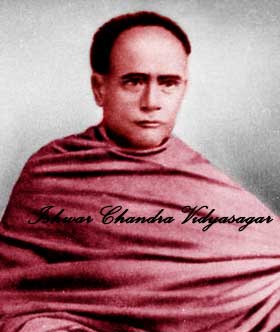Pandit Ishwar Chandra Vidyasagar: The Inspiration for a New Generation
Ishwar Chandra Vidyasagar was not truly a writer in the sense that Bankimchandra and others of his time were. His writings were instructive, reformative and utilitarian, not creative.
Pandit Ishwar Chandra Vidyasagar

Ishwar Chandra Vidyasagar: Pandit Ishwar Chandra Vidyasagar, a Sanskrit pandit, was an educator, reformer, writer, and a philanthropist. He was considered to be one of the greatest intellectuals and activists of the nineteenth century.
Ishwar Chandra Vidyasagar was born in 1820 in a Brahmin family at Birmingham in Midnapore district. His parents, though poor, managed to send him to Calcutta (now Kolkata) for studies after he finished his early education at the village pathshala.
Ishwar studied at the Sanskrit College, Calcutta (now Kolkata) from 1829 to 1841. He bagged all the prizes and scholarships for the best performance.Evaluating his performance in various courses – poetry, rhetoric, Vendanta, Smrti, astrology and logic, the College Committee endowed Ishwar Chandra with the title of Vidyasagar (sea of knowledge) in 1839.
At the age of 21, Ishwar Chandra Vidyasagar started his career as the head pandit of the Fort William College, Calcutta (now Kolkata).He joined the Sanskrit College as a professor in 1850. In the following year, he became the principal of the college.
Concurrently, with his Sanskrit College position, the government entrusted him in 1855 with the added responsibility of the Special Inspector of Schools for the districts of Hooghly, Burdwan, Midnapore, and Nadia. He was likewise a privileged office conveyor of a few associations including Asiatic Society and Bethune Society. In 1858, he was made one of the first fellows of the Calcutta University.
Ishwar received a certificate of Honour at the Imperial Assemblage in January 1877 and in January 1880, was made a CIE. He additionally got distinctions and felicitations from numerous social, social and logical organizations.
Ishwar Chandra Vidyasagar was not truly a writer in the sense that Bankimchandra and others of his time were. His writings were instructive, reformative and utilitarian, not creative. His earliest works including Mahabharata Upakramanika (serialized in the Tattvabodhini Patrika (1843-44) and Vetalapanchavinshall (1847), were translations.
Pandit Ishwar Chandra Vidyasagar
The majority of his works, 32 in all, were directly or indirectly translations from Sanskrit, Hindi, and English. These were mainly textbooks addressed to school students. His only independent scholarly study, but which remains obscure among the generality, is Sanskrit Bhasa O Sanskrit Sahitya Shastra Bisyak Prastab (Propositions on Sanskrit Language and Literature. 1853). But though a textbook writer essentially.
Vidyasagar is rated by the established writers of his own time as an art writer and inspiring educator. In his hands, the Bangla prose style took a new turn. According to critics. Vidyasagar inaugurated a new era in the Bangla prose literature.
A reformer of Bangla prose style, Vidyasagar as a writer had consciously avoided the new but affected prosody pursued by the orientalists at Fort William College, the pedantic and obscurantist style of Rammohan Roy and his followers, and the unrefined linguistic structure of the contemporary newspapers and periodicals. Instead, he charted out for himself a new course which soon laid the foundation of the modern Bangla prose. Here lies the uniqueness of Vidyasagar’s contributions.
Since his style found expression in his textbooks essentially and since his books were prescribed commonly in all government and vernacular schools until the early years of the twentieth century, several generations of writers, officers and professionals were very directly and permanently influenced by the Vidyasagarian prose style, the hallmark of which was a grand synthesis of past and present techniques of Bangla language and literature.
Vidyasagar was a great reformer and thinker. In his Banglar Itihas, he has aptly shown, contrary to Marshman’s theory, the marked syncretic and synthetic trends of Bengal’s social and cultural developments. Though personally an orthodox Hindu, Ishwar Chandra perceived other religionists entirely secularly.
Pandit Ishwar Chandra Vidyasagar
Vidyasagar’s improving personality has discovered most solid articulation in his socio-religious musings. He brought up issues about early marriage, polygamy, widow remarriage, and numerous different ills smothering social developments.
Most of his reform thoughts were embodied in his two famous works: Bidhababibaha Prachalita Hoya Uchit Kitna Etadvisayak Prastab, 2 vols. Polygamy, widow remarriage, youngster marriage were touchy issues because these were upheld by the Hindu religion.
Vidyasagar did not mean to hurt the religious sentiments of the common people by directly attacking the evils. In defense of his arguments, he profusely drew instances from the Shastras and other classical texts, a stratagem which had a tremendous impact on the people. His sastra-based and humorous arguments made the defenders of those social evils largely defenseless, though many of the conservatives maligned him savagely.
The institution of the Act of 1856, authorizing widow remarriage and the Civil Marriage Act of 1872, limiting plural marriage and kid marriage and empowering widow remarriage, owed a great deal to Vidyasagar, whose writings and activities had helped to create public opinion in favor of these issues.
As Special Inspector of Schools, Vidyasagar used his position to encourage landholders and other solvent people to establish educational institutions. Within his inspection zone, he was instrumental in founding dozens of schools, several of which were for girls. Some schools were set up at his drive and with his monetary support.
Vidyasagar’s monumental contribution to educational institution building was his Calcutta Metropolitan Institution, a model college with attached schools, which he established in 1864 at his own cost. He also funded the erection of the magnificent building housing the Metropolitan Institution. Vidyasagar’s philanthropy was proverbial. It is said that a large portion of the cash that he got from his pay and his eminences was kept saved for helping the distressed.
His stature as an educator, reformer, writer and philanthropist grew to such a height that, at his death on July 29, 1891, the whole nation, irrespective of race, religion, and caste, mourned. The papers and magazines distributed tribute and highlight hailing his deeds and accomplishments; artists and essayists, including Rabindranath Tagore, composed lyrics and highlights in his memory.
In these remembrances and recollections, Vidyasagar was rated as the greatest man of the century. The evaluation remains unchanged even today.





